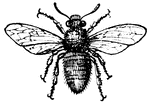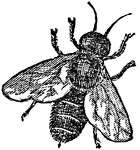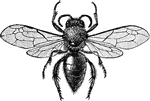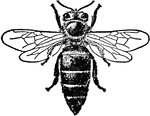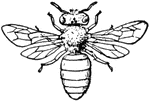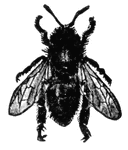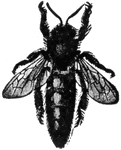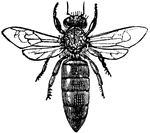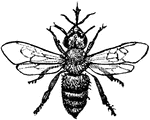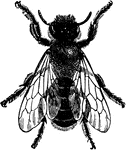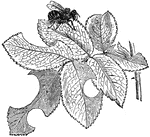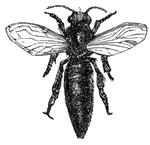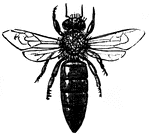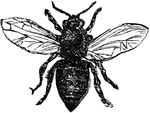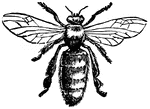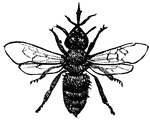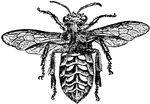Clipart tagged: ‘kbees’
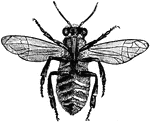
Bee
"Bee seen through a magnifying-glass at the moment when the plates of wax appear between the segments…

Bee Head
"Head and mouth parts of bee. a., Antenna; m., mandible; g., labrum or epipharynx; mx.p., rudiment of…
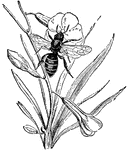
Bee Pollinating a Flower
"Bee, the common name given to a large family of hymenopterous or membranous-winged insects, of which…
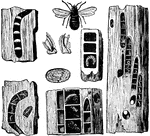
Carpenter Bee, Pupae, Eggs, Galleries and Nests
"The Carpenter Bee, or Wood Piercer, hollows out galleries in decayed wood, and builds in them cells…
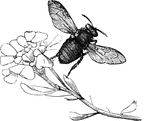
Drone Bee
"The working bee, for collecting wax, enters a flower, the stamens of which are loaded with pollen.…

Drone Bee
"Bee is the common name given to a large family of hymenopterous or membranous-winged insects, of which…
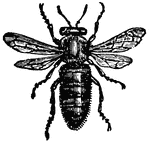
Female or Queen Bee (Apis Mellifica)
"The female is smaller than the male, and has a longer body than the working bee; the wings are shorter…
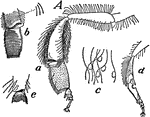
Legs of the Hive Bee
Honey bees (or honeybees) are a subset of bees, primarily distinguished by the production and storage…
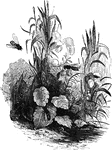
Honey Bee
"They are said to have originated in Greece, but have since spread all over the world; they live in…

Honey Bee (Male)
Honey bees (or honeybees) are a subset of bees, primarily distinguished by the production and storage…
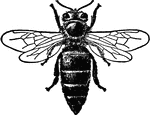
Honey Bee (Queen)
Honey bees (or honeybees) are a subset of bees, primarily distinguished by the production and storage…

Honey Bee (Worker)
Honey bees (or honeybees) are a subset of bees, primarily distinguished by the production and storage…
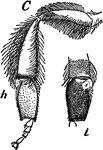
Legs of the Humble Bee
A bumblebee (or bumble bee) is any member of the bee genus Bombus, in the family Apidae. Pictured here…

Larva of the Bee
"As the larva increases in size, its food is made to acquire a more decided taste of honey. In the space…

Leaf-Cutter Bee
A leaf-cutter bee, Megachile species. Leaves cut from leaf-cutter bee in a burrow in a dead branch.
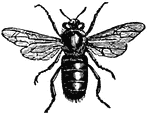
Male or Drone Bee (Apis Mellifica)
"The males are larger and more hairy than the working bee, emitting a sonorous and buzzing sound, have…
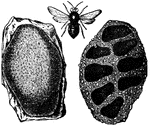
Mason Bee and Nest
"The Mason Bees build their nests against the walls with tempered earth, which becomes very hard."
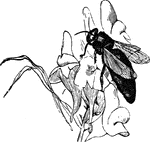
Queen Bee
"The queen bee is larger and longer than the other bees; she moves in a slow and majestic manner, and…
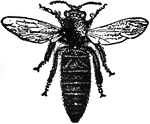
Queen Bee
"Bee is the common name given to a large family of hymenopterous or membranous-winged insects, of which…

Legs of the Stingless Bee
Stingless bees, or simply meliponines, are a large group of bees, comprising the tribe Meliponini in…

Worker Bee
"Bee is the common name given to a large family of hymenopterous or membranous-winged insects, of which…

Working Bees
""The working bee, for collecting wax, enters a flower, the stamens of which are loaded with pollen.…
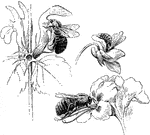
Bees Visiting Flowers
"Bees visiting flowers. At the left, a bumblebee on the flower of the dead nettle; below, a similar…
Honey Bees
"Honey bee (Apis mellifica). a, queen (perfect female); b, worker (imperfect female); and c, drone (male)."…
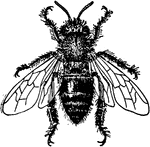
Honey Bees
Bees are flying insects closely related to wasps and ants. Honey bees (or honeybees) are a subset of…

Honey Bees
Bees are flying insects closely related to wasps and ants. Honey bees (or honeybees) are a subset of…
